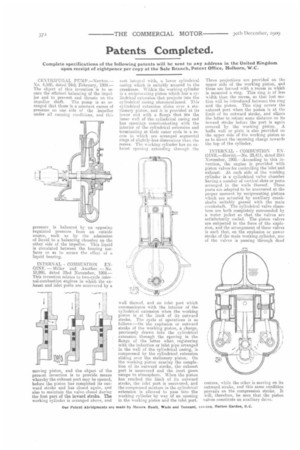Patents Completed.
Page 20

If you've noticed an error in this article please click here to report it so we can fix it.
Complete specifications of the following patents will be sent to any address in the United Kingdom upon receipt of eightpence per copy at the Sale Branch, Patent Office, Holborn, lAr.C.
CENTRIFUGAL PaMP.—Newton.— Nn. 4,550, dated 24th February, 1909.— The object of this invention is to secure the efficient balancing of the impellor and to prevent end thrusts on the
impeller shaft. The pump is so arranged that there is a constant excess of pressure on one side of the impellor under all running conditions, and this
pressure is balanced by an opposing regulated pressure from an outside source, such as by the admission of liquid to a balancing chamber on the other side of the impellor. This liquid is circulated between the bearing surfaces so as to secure the effect of a liquid bearing.
INTERNAL COMBUSTION ENGINE. — Miller and Another. — No. 10,998, dated 23rd November, 1908.— This invention relates to two-cycle internal-combustion engines in which the exhaust and inlet ports are uncovered by a
moving piston, and the object of the present invention is to provide means whereby the exhaust port may be opened, before the piston has completed its outward stroke and has closed again, and also to maintain the valve closed during the first part of the inward stroke. The working cylinder is arranged above, and east int e 41 al with, a lower cylindrical easing which is suitably scoured to the crankcase. Within the working cylinder is a reciprocating piston which has a cylindrical extension that projects into the cylindrical casing aforementioned.' This cylindrical extension slides over a stationary piston, and it is provided at its lower end with a flange that tits the inner wall of the cylindrical casing and has openings communicating with the interior of the cylindrical extension and terminating at their outer ends in a, recess in which are arranged segmental rings of slightly-less dimensions than the recess. The working cylinder has an exhaust opening extending through the
wall thereof, and an inlet port, which communicates with the interior of the cylindrical extension when the working piston is at the limit of its outward stroke. The cycle of operations is as follows :—On the explosion or outward stroke of the working piston, a charge, previously drawn into the cylindrical extension through the opening in theflange of the latter when registering with the induction or inlet pipe arranged in the wall of the cylindrical casing, is compressed by the cylindrical extension sliding over the stationary piston. On the working piston nearing the completion of its outward stroke, the exhaust port is uncovered and the inert gases escape to atmosphere. When the piston has reached the limit of its outward stroke, the inlet port is uncovered, and the compressed mixture in the cylindrical extension is allowed to pass into the working cylinder by way of an opening in the working piston and the inlet port. Three projections are provided on the upper side of the working piston, and these are formed with a recess in which is mounted a ring. This ring is of less width than the recess, so that lost motion will he introduced between the ring and the piston. This ring covers the exhaust port when the piston is at the limit of its outward stroke, and allows the latter to return some distance on its inward stroke before the port is again covered by the working piston. A baffle wall or plate is also provided on the upper side of the working piston so as to direct the incoming charge towards the top of the cylinder.
INTERNAL COMBUSTION ENGINE.—IIewitt.—No. 25,411, dated 25th November, 1908.—According to this invention, the engine is provided with piston valves for controlling the inlet and exhaust. At each side of the working cylinder is a cylindrical valve chamber having a number of vertical slots or ports arranged in the walls thereof. These ports arc adapted to be uncovered at the proper moment by reciprocating pistons which are actuated by auxiliary crankshafts suitably geared with the main crankshaft. The cylindrical valve chambers are both completely surrounded by a water jacket so that the valves are satisfactorily cooled. The piston valves are subjected to theforce of the explosion, and the arrangement of these valves is such that, on the explosion or power stroke of the main working cylinder, one of the valves is passing through dead centres, while the other is moving on its outward stroke, and this same condition prevails on the compression stroke. It will, therefore, be seen that the piston valves constitute an auxiliary drive.




















